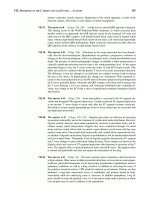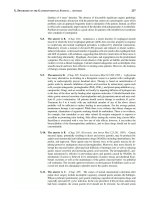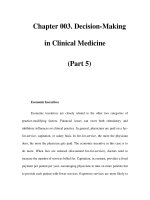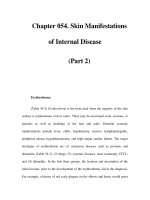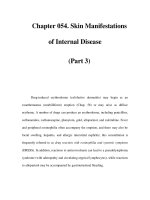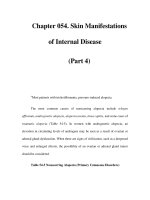Chapter 054. Skin Manifestations of Internal Disease (Part 5) pptx
Bạn đang xem bản rút gọn của tài liệu. Xem và tải ngay bản đầy đủ của tài liệu tại đây (73.52 KB, 5 trang )
Chapter 054. Skin Manifestations
of Internal Disease
(Part 5)
a
To date, FDA-approved for men.
b
May also be scarring.
Exposure to various drugs can also cause diffuse hair loss, usually by
inducing a telogen effluvium. An exception is the anagen effluvium observed with
antimitotic agents such as daunorubicin. Alopecia is a side effect of the following
drugs: warfarin, heparin, propylthiouracil, carbimazole, vitamin A, isotretinoin,
acitretin, lithium, beta blockers, colchicine, and amphetamines. Fortunately,
spontaneous regrowth usually follows discontinuation of the offending agent.
Less commonly, nonscarring alopecia is associated with lupus
erythematosus and secondary syphilis. In systemic lupus there are two forms of
alopecia—one is scarring secondary to discoid lesions (see below) and the other is
nonscarring. The latter form may be diffuse and involve the entire scalp, or it may
be localized to the frontal scalp, eventually resulting in multiple short hairs ("lupus
hairs"). Scattered, poorly circumscribed patches of alopecia with a "moth-eaten"
appearance are a manifestation of the secondary stage of syphilis. Diffuse thinning
of the hair is also associated with hypothyroidism and hyperthyroidism (Table 54-
4).
Scarring alopecia is more frequently the result of a primary cutaneous
disorder such as lichen planus, folliculitis decalvans, chroniccutaneous (discoid)
lupus, or linear scleroderma (morphea) than it is a sign of systemic disease.
Although the scarring lesions of discoid lupus can be seen in patients with
systemic lupus, in the majority of cases the disease process is limited to the skin.
Less common causes of scarring alopecia include sarcoidosis (see "Papulonodular
Skin Lesions," below) and cutaneous metastases.
In the early phases of discoid lupus, lichen planus, and folliculitis
decalvans, there are circumscribed areas of alopecia. Fibrosis and subsequent loss
of follicles are observed primarily in the center of the individual lesions, while the
inflammatory process is most prominent at the periphery. The areas of active
inflammation in discoid lupus are erythematous with scale, whereas the areas of
previous inflammation are often hypopigmented with a rim of hyperpigmentation.
In lichen planus the peripheral perifollicular macules are usually violet-colored.
Complete examination of the skin and oral mucosa combined with a biopsy and
direct immunofluorescence microscopy will aid in distinguishing these two
entities. The peripheral active lesions in folliculitis decalvans are follicular
pustules; these patients can develop a reactive arthritis.
Figurate Skin Lesions
(Table 54-6) In figurate eruptions, the lesions form rings and arcs that are
usually erythematous but can be skin-colored to brown. Most commonly, they are
due to primary cutaneous diseases such as tinea, urticaria, erythema annulare
centrifugum, and granuloma annulare (Chaps. 53 and 55). An underlying systemic
illness is found in a second, less common group of migratory annular erythemas. It
includes erythema gyratum repens, erythema migrans, erythema marginatum, and
necrolytic migratory erythema.
Table 54-6 Causes of Figurate Skin Lesions
I. Primary cutaneous disorders
A. Tinea
B. Urticaria (≥90% of cases)
C. Erythema annulare centrifugum
D. Granuloma annulare
E. Psoriasis
II. Systemic diseases
A. Migratory
1. Erythema migrans
2. Urticaria (≤10% of cases)
3. Erythema gyratum repens
4. Erythema marginatum
5. Pustular psoriasis
6. Necrolytic migratory erythema (glucagonoma syndrome)
a
B. Nonmigratory
1. Sarcoidosis
2. Subacute lupus erythematosus
3. Secondary syphilis
4. Cutaneous T cell lymphoma (e.g., mycosis fungoides)
